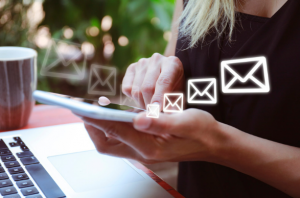Various technologies and tools have risen to prominence, and many fell from grace and just vanished from the scene. But the dominance of email remains unflinching even today.
Not only is email the most preferred means of communication today, but it consistently tops the list of marketing channels with the best conversion rate. And one of the many benefits of email marketing is that it can be automated.
With email automation, targeted messages can be scheduled by marketers or automatically be sent when a user performs a specific action on a website. This is an effective method to nurture existing leads.
Additionally, it can also be used to engage with new customers and reach and interact with past customers. This then reminds them about your brand and gives them information regarding new deals, promotions, and more.
When you implement email marketing automation, you can eliminate time-consuming tasks. This includes sending generic messages and/or scheduling events manually. Email automation is a powerful process based around pre-determined workflows with a triggered set of actions that you direct your automation software to take.
 How does email automation work?
How does email automation work?
Automation of email marketing can be accomplished with the help of email marketing apps. A campaign and a trigger are the key to this strategy, where an automated sending will activate once a predetermined event occurs or is triggered.
Before anyone can start receiving your messages, you must specify a set of conditions and put them into a workflow. When a subscriber meets the conditions, you have specified in the scenario, it triggers the system to send out your email.
With email automation, your customers are automatically integrated into your system once they perform any action that you track. Your system will send them messages without any additional demands based on their behaviour, without putting additional strain on your limited resources.
At a very high level, marketing automation campaigns send specific content to your leads based on their behaviour and available data.
Each email automation tool may have variances in how they work, but their basic flow can be like the following:
- A person visits your website and downloads a resource after filling in a form.
- They are automatically added to your email marketing database.
- They are out into different audience segment based on their location, interests, behaviour, etc.
- Your marketer creates an email campaign. Rules/triggers are set up and schedule the emails, etc.
- The person receives the email based on campaigns and conditions set by your marketer.
What is a pre-determined/trigger action?
With email automation, triggers can be a specific date, an event, or any contact’s activity that will tell your system to send out a related message. You can determine or choose the triggers, and which triggered messages are sent out based on your contact’s journey.
Let us cite an example at the very start of your customer’s journey:
- Trigger: New sign-up / New subscriber
- Email: Welcome!
Looks simply, isn’t it? It should be because it is designed to be so. Looking at the example above, the trigger is the sign-up, and your system will automatically send your welcome email once a successful sign-up is accomplished.
Even if a website is an e-commerce store/site, most first-time users or visitors won’t be ready to make a purchase. But once you acquire a new subscriber, a “welcome” follow-up can help turn new leads into customers with little to no extra effort.
Other example of triggers when emails can be automatically sent:
- Purchasing an item/service on your website – You have now persuaded your customer to buy from you. In the “Purchase/Order/Shipping Confirmation” email, you can now include a “Thank You” message. After that, you can send “Cross-Sell” emails, or you can also send “Upsell” emails.
- Submitting an enquiry – Your response can include “Recommendations.” If you really want to deliver value to your customers, you must pay close attention to how they interact with your brand.
- Signing up/Getting added to a newsletter list – Newsletters helps you get in touch with your users and bring them back to your website, ultimately to convert them into customers.
- Downloading a Free Resource (aka Lead Magnet) – Send a “Thank You” and send more value that matches with the subscribers’ interest.
- Abandoned Carts – It only takes a click to add to cart, but more than 70% abandon their carts for many reasons. Recover these lost sales with a “Forget Something?” email.
What conditions can be set for email automations?
Email automation workflows include:
- Sending Options – This includes the type of communication being sent out such as email campaigns/series, 1 to 1 email or even SMS.
- Delivery Options – Specifies a time trigger, such as a date and/or time when communication is sent out. It also specifies when the next email, such as in a series, will be sent out.
- Consumer Journey Options – In these cases, corresponding emails are automatically sent once a certain amount of time is reached, or they hit another established trigger
- CRM Integrations – Integrate your marketing automation activities with a CRM tool, so you have a single source of truth for your sales and marketing data. Your leads can be uploaded, stored, and managed in detail, including information such as name, address, email, type of customer, phone number, purchase history, and website.
The Growth Manager is here to provide you with just-in-time learning with our Email Marketing Strategy for you and you to take advantage of email automation. A lot more of us can be successful in sales if armed with the right training tools. Join us today and let the growing begin.





